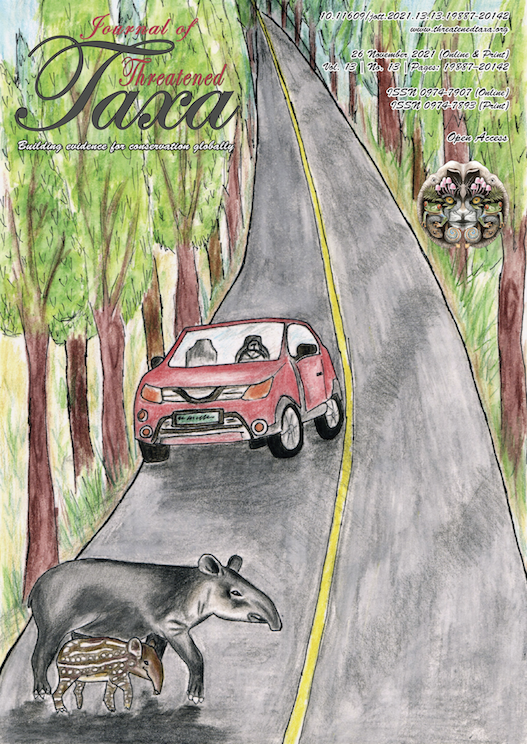Recovery of vulture population in roosting and scavenging areas of Bastar and Bijapur, Chhattisgarh, India
Main Article Content
Abstract
Chhattisgarh is home to seven of the nine vulture species in India. One reason for this high vulture diversity is the presence of large herds of bovines numbering over 11 million individuals (ratio of human to bovine population is approximately 0.38), from which carcasses are disposed off in the open for scavengers. The late 1990s saw large scale decimation of vulture population, and since then there have been few studies with no sighting estimates available. In this study, concurrent sighting records were collected from different locations of southern Chhattisgarh and corroborated to develop conservative sighting estimates for sympatric populations of Gyps bengalensis and Gyps indicus. We present the first report on population recovery, with an estimated 30–35 Gyps bengalensis & 20–25 Gyps indicus in/ around Rudraram of Bijapur and 18 Gyps bengalensis & five Gyps indicus at Jamguda village of Bastar. Krishna Swami Gutta hill is identified as a nesting-roosting habitat for both species, for which six scavenging areas were identified in Bastar and Bijapur districts. The human/bovine population ratio for Bastar is 0.4, similar to the state ratio, while in Bijapur the ratio is 1.07, which justifies considering Bijapur as a conservation refuge. The few vultures that survived the diclofenac catastrophe in wild habitats most likely consumed wildlife carcasses that sustained a residual population. In these areas, the age-old practise of disposing off dead domesticated bovines away from settlements near reserve forests may also have supported the recovery of vulture population.
Article Details

This work is licensed under a Creative Commons Attribution 4.0 International License.
Authors own the copyright to the articles published in JoTT. This is indicated explicitly in each publication. The authors grant permission to the publisher Wildlife Information Liaison Development (WILD) Society to publish the article in the Journal of Threatened Taxa. The authors recognize WILD as the original publisher, and to sell hard copies of the Journal and article to any buyer. JoTT is registered under the Creative Commons Attribution 4.0 International License (CC BY), which allows authors to retain copyright ownership. Under this license the authors allow anyone to download, cite, use the data, modify, reprint, copy and distribute provided the authors and source of publication are credited through appropriate citations (e.g., Son et al. (2016). Bats (Mammalia: Chiroptera) of the southeastern Truong Son Mountains, Quang Ngai Province, Vietnam. Journal of Threatened Taxa 8(7): 8953–8969. https://doi.org/10.11609/jott.2785.8.7.8953-8969). Users of the data do not require specific permission from the authors or the publisher.
References
Birdlife International (2021). Species factsheet: Gyps bengalensis and Gyps indicus. Downloaded from http://birdlife.org
Birdlife International (2021). IUCN Red List for birds. Downloaded from http://birdlife.org
Chhattisgarh State District-wise Cattle population (2019). 20th Livestock Census, 1-7. http://agriportal.cg.nic.in/ahd/PDF_common/census20th/2_Districtwise_Animal_population_20th_LSC.pdf
Cuthbert, R., M.A. Taggart, V. Prakash, M. Saini, D. Swarup, S. Upreti, R. Mateo, S.S. Chakraborty, P. Deori & R.E. Green (2011). Effectiveness of action in India to reduce exposure of Gyps vultures to the toxic veterinary drug Diclofenac. PLoS One 6(5): e19069. https://doi.org/10.1371/journal.pone.0019069
Ghosh, S., R.S. Basu, B.K. Datta & A.K. Sett (2008). Fauna of Madhya Pradesh (including Chhattisgarh), State Fauna Series, 15 (Part 2), Aves. Zoological Survey of India, Kolkata, 152pp.
Green, R.E., I. Newton, S. Shultz, A.A. Cunningham, M. Gilbert, D.J. Pain & V. Prakash (2004). Diclofenac poisoning as a cause of vulture population declines across the Indian Subcontinent. Journal of Applied Ecology 41(5): 793–800.
Grimmett, R., C. Inskipp & T. Inskipp (2011). Birds of the Indian Subcontinent, Christopher Helm, London, 528pp.
Indian State of Forest Report (2019). 11.5 Chhattisgarh, 44-53. http://www.indiaenvironmentportal.org.in/files/file/isfr-fsi-vol2.pdf
Naoroji, R. (2011). Birds of Prey of the Indian Subcontinent. Om Books International, New Delhi, 692pp.
Prakash, V., D.J. Pain, A.A. Cunningham, P.F. Donald, N. Prakash, A. Verma, R. Gargi, S. Sivakumar & A.R. Rahmani (2003). Catastrophic collapse of Indian white-backed Gyps bengalensis and long-billed Gyps indicus vulture populations. Biological Conservation 109: 381–390.
Prakash, V., M.C. Bishwakarma, A. Chaudhary, R. Cuthbert, R. Dave, M. Kulkarni, S. Kumar, K. Paudel, S. Ranade, R. Shringarpure & R.E. Green (2012). The population decline of Gyps vultures in India and Nepal has slowed since veterinary use of diclofenac was banned. PLoS One 7(11): e49118. https://doi.org/10.1371/journal.pone.0049118
Saini, M., M.A. Taggart, D. Knopp, S. Upreti, D. Swarup, A. Das, P.K. Gupta, R. Niessner, V. Prakash, R. Mateo & R.J. Cuthbert (2012). Detecting Diclofenac in livestock carcasses in India with an ELISA: a tool to prevent widespread vulture poisoning. Environmental Pollution 160(1): 11–16. https://doi.org/10.1016/j.envpol.2011.09.011
Unique Identification Aadhar India. Updated 31 May 2019. http://www.populationu.com/in/chhattisgarh-population

